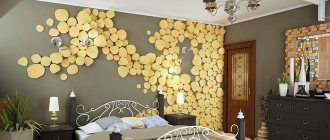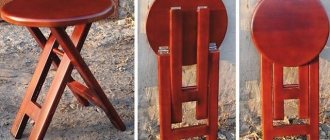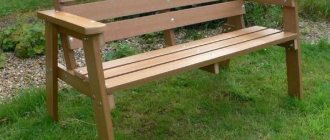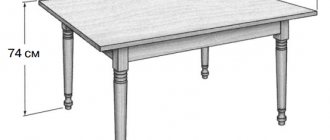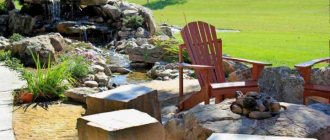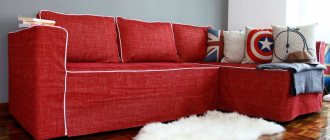How to make aged wood at home and give it a vintage look with your own hands? This article is dedicated to just such tricks! Artificially aged items look very stylish and harmonious!
The 7 methods for aging wood with paint that we will look at here are interesting for their simplicity and excellent end result. They also do not require the purchase of any expensive special materials or tools.
We will analyze in detail the following 7 painting methods:
Preparatory work
When choosing what to do with old but high-quality furniture, many people prefer to decorate it with original elements and change the style.
Repair is not only much cheaper than purchasing new products, it allows you not to part with your favorite things, while radically changing the design of the room. If you decide to make a piece of furniture yourself, you need to draw up drawings and detailing diagrams. This can be done manually using paper, pencil and ruler. A more advanced option is to use a special computer program.
If aging used furniture is chosen as a finishing option, it should be carefully prepared. Before the main work, we remove all existing fittings: be sure to unscrew the handles and remove decorative elements. After this, the tree is cleared of its previous coating. Paint and old varnish are removed from the furniture, and the surface is sanded using fine sandpaper. Work is carried out manually or using power tools. Significant cracks and chips are repaired with hard furniture wax. Minor problems are left on purpose - the presence of scratches and traces of knots adds age to the product. Then the surfaces are primed with a special composition for wood and painted in tones characteristic of the chosen style. When aging new furniture, you can immediately begin the finishing process.
Special decoration allows you to get furniture in the Provence style with your own hands for a summer house or country house. Flowers on wallpaper or curtains will be the final link in the composition. The easiest way to age furniture in this manner is to rub the surface with a regular candle before painting. The result will be an uneven application of layers of paint, creating the appearance of long-term use of the item.
Remove fittings, handles and decorative elements
Clear the wood of its previous coating
Cracks and chips can be easily repaired with hard furniture wax
Prime the surface of the product
Paint in your chosen color
Aging using wet paper
This method of giving wood an aged texture is similar to the previous one with candles, only now instead of wax there will be wet paper (if you suddenly don’t have a candle at home, then everyone certainly has paper).
Necessary materials:
Step-by-step instruction:
Step 1: Attach wet paper. No base paint was applied here so that the natural color of the wood could be seen. Therefore, we immediately take a sheet of paper and tear it into uneven pieces of different shapes and sizes. After this, dip each piece into a bowl of water and place it on the wood you are going to paint.
Step 2: Apply paint
Having laid out all the pieces of paper, immediately start painting in the chosen color, that is, you do not need to wait until the paper dries.
Step 3: Peeling off the paint Next, carefully lift each piece of paper from the surface. You can do this while the paint is still a little damp, or after it has completely dried.
You can make several layers, for example, as in the previous method. To do this, follow the step-by-step instructions described there, replacing the wax with damp paper.
Design of antique furniture and appliances
Do-it-yourself round table: design, projects, diagrams and step-by-step description of how to make and where best to place a round table (110 photos)
If you decide to create an antique interior in the kitchen, then you need to choose its elements according to the design. So, furniture can be not only made of wood, but also:
- forged;
- wicker;
- stone;
- brick.
Stone can be used to create cabinet cabinets in the kitchen, where there are shelves for storing accessories, or where built-in appliances are located.
However, regardless of the material of the headset, it should have a fairly simple appearance. If desired, the facades should be replaced with chintz curtains. Excellent antique interior elements in the kitchen will be:
- chests;
- rough stools;
- benches.
If household appliances cannot be hidden behind curtains and facades, then it is recommended to choose them in a style that is harmonious for the interior - based on enamel or metal, the same applies to plumbing fixtures. Faucets made of bronze or copper, counter-mounted stone sinks and much more are perfect.
Technology of work execution
DIY table: overview of the main models and step-by-step instructions on how to make a unique homemade table (130 photos)
There are several techniques that can transform old furniture and radically change the facade of the furniture wall and its appearance.
Crackle
The whole process is based on the use of a special varnish called “craquelure”. This is a certain substance through which artistic microcracks begin to appear on the surface. The varnish is best used for processing wooden or glass objects
To ensure that antique furniture is painted correctly, it is important to follow the following instructions:
- On the previously prepared surface we apply the first layer of paint - the base. When microcracks appear, they will take on the shade of the base;
- Once the base has dried, you can apply the craquelure. In this case, all strokes should be performed strictly in one direction;
- After drying, apply the color as the finishing coat. As a result of its use, long-awaited cracks appear;
- We cover the resulting effect with furniture fixing varnish.
This method is perfect for those craftsmen who want to bring back the country or Provence style on their own. Making aged furniture using this technique will take very little time.
Apply paint Apply craquelure varnish Let the coating dry
Patina
Over the years, veins of a greenish-bronze color appear on the furniture, which indicates the “old age” of the item. This is patina. It is the result of high humidity or exposure to large amounts of precipitation. To achieve an illusory effect, you must take the following steps:
Varnish the wood. It is recommended to use a special mixture that will protect the furniture from harmful external influences and extend its service life; We wait until the mixture hardens completely and apply a patina to the surface; After a half-hour rest, you can start working with a wire brush.
It is important to note that the greater the effort, the brighter the effect becomes; Using a rag, we remove by-products of work in the form of dust; As in the first method, we finish the job with furniture varnish.
We wipe off the old paint, we prime the coating, we paint the surface, we apply a patina, we wipe the coating with a rag, we coat it with varnish.
Coloring
The main work is carried out using several colors. To achieve an antique effect, follow these instructions:
- To create the effect of clumsiness and shabbyness, it is necessary to inflict minor mechanical damage. This results in artificial aging of furniture, for example, the effect of old Soviet furniture, because it cannot be in perfect condition;
- We apply paint in such a way as to preserve the texture of the material;
- We go over the surface with sandpaper to form spectacular abrasions;
- Take paint of a different color, apply it with neat strokes and shade it.
Making cracks Painting the surface Sanding again Applying a layer of paint
Effect of artificial pollution
Things tend to get dirty and covered with dust over time. To produce a similar effect, do the following:
- Selectively apply wax to some areas of the surface. Movements should be in the same direction, but with breaks. Next, coat the item with varnish;
- If recesses were found on the item, the varnish will give them a darker shade, visually enhancing the effect of antiquity.
Any furniture, regardless of material or decorative design, requires proper care for a longer service life
It is worth paying attention to the following methods:
- We rub old chipboard furniture with our own hands with mastic or wax. They contribute to the formation of protection against high humidity and repel water. The compositions should be rubbed using a rag or a soft sponge;
- In addition, acrylic or a special varnish containing it is perfect. It must be applied periodically to “renew” the protection. You can cover the surface of the object with a mixture of acrylic and wax;
- When dust accumulates, the furniture loses its presentable appearance, so we periodically wipe it with an ordinary lint-free cloth.
Apply wax and varnish
Rinse method
This method for creating the effect of old wood is suitable for elegant furniture in a rustic or Provence style. It is best used on damp wood.
Necessary materials:
- paint, brush,
- water, rag.
Instructions:
- Apply a coat of paint and let it dry for a few minutes (same as the previous method, so it's still tacky and not completely dry).
- After this, quickly rinse the wood with water , carefully wiping the surface with a rag. The goal is to wash away some of the paint on the surface. Leave to dry. That's all!
For example, a table painted soft green looks simply wonderful after using this method.
Antique wooden furniture design: decor variations
Management. how to make a table-cabinet (table-book) with your own hands
Any unremarkable chair, cabinet, dining or desk made of solid wood can become an expressive art object. Amazing transformations of furniture can be easily accomplished using various arts and crafts techniques and methods for transforming wooden parts:
- whitening;
- staining;
- varnishing;
- grinding;
- toning;
- wax treatment with imitation patina;
- coating with paint with a craquelure effect;
- paintings.
Wood is a plastic material that can be easily processed. By using the above methods, you can modify wood carpentry at home, giving them a characteristic touch of antiquity.
To create a luxurious-looking interior composition in the Art Deco or Neoclassical style, it is enough to use unique furniture with an antique design as accent details. It must be made of valuable wood species - wenge, zebrawood, oak, mahogany or teak.
Filigree wood carving, gilding and silvering of panels gives the carpentry a luxurious antique look. It is advisable to perform such furniture decoration when arranging palace interiors. Large costs for their design can be significantly reduced by purchasing or restoring dilapidated armchairs, sofas, beds, dressing tables and other furniture products. Even tacky-looking furnishings will take on a respectable appearance with skillfully done reupholstery, repair of broken parts and hand-made antique decor.
Antique wood burning
Heat treatment opens up enormous possibilities. With its help, the following is applied to wood:
- its own unique design, because any cut is created by nature, which never repeats itself in anything;
- during firing, the shades change, the appearance of coal particles gives more expressiveness to the wood;
- Using old boards from which the old paint has been removed by fire, they achieve real aging of the product for several decades.
Firing is performed using the tools presented in the table.
Table
Wood burning tools
Features of decorating an antique kitchen
Even a very fashionable and modern kitchen can be artificially aged if you use some techniques and decorative items:
- The wooden facades of the cabinet can be slightly sanded, partially removing the layer of varnish or paint from them, or you can use one of the previously listed aging methods;
- remove the cabinet doors and place wicker baskets on the shelves;
- One of the classic elements of an ancient kitchen is a stove or hearth. In a modern room, you can create an imitation of them in the cooking area or lay out a large false fireplace next to a wall where there is no furniture, made of artificial stone. Another imitation option is photo wallpaper in the form of a full-size fireplace;
- To create an antique interior, you can hang ancient kitchen utensils along the walls, place jars on shelves, and place trays and pots next to them;
- choose the right textiles for the interior - bright potholders and embroidered tablecloths, lay woven ancient rugs on the floor;
- hang lamps decorated in antique style;
- decoration using braids based on garlic and onions, bunches of dried herbs, as well as vegetables in wicker baskets.
To create an original antique interior, wood should be used as a defining element; it can be artificially aged using special techniques that were described above. In addition, the interior of the kitchen or other room should be supplemented with antique decorative elements and objects that emphasize the chosen style.
Working on brick
Working with brick is the easiest, since it itself has an old-fashioned look. The instructions have only one simple step - painting with acrylic paints of the selected colors. The only difference between this type of painting and the usual one is the method of applying the paint.
So, antique-looking brick painting should be done with a sponge. How to paint plastic panels to look like wood? It is simply dipped in paint and applied to the surface of the brick with light touches.
Brick painted antique with different paints
To enhance the effect of antiquity, before painting the brick antique, the joints of the masonry are rubbed with ordinary earth, making them darker or painted over with paint of any color.
Secrets of restoring wooden furniture with your own hands
You may also find useful recommendations on how to update wooden furniture with your own hands. For old wooden structures, the following decoration options are used:
paint coating;
Using paint for restoration work
decoupage technique;
Original decoupage with antique effect
veneering or lamination;
Using this type of processing you can create modern pieces of furniture.
using adhesive tape;
This method will allow you to radically change the product
processing with paint and varnish solutions.
Using paint you can apply unusual patterns
You can even combine different restoration techniques. In any case, do not forget about sanding. Original products will be obtained by using paint painting. The ornament can be chosen in advance. After applying the design, the surface must be varnished.
The surface can be decorated with patterns using templates and then covered with varnish solution
For a decoupage-style design, you can choose a napkin with a beautiful pattern or even newspaper clippings.
Decoupage with antique effect
Original decor for the entire set
Using decor, you can make a Provence style option out of old furniture
Beautiful homemade furniture will become the pride of the master. Wood products, when properly processed, can last a very long time. The process of creating furniture yourself will allow you to not only enjoy the work, but also bring creative ideas to life.
The video shows a DIY version of the kitchen set:
Watch this video on YouTube
You can also watch the video on how to paint old furniture:
Watch this video on YouTube
Previous Furniture Transformable coffee and dining table: design features and original solutions Next Furniture Attic bed for adults and children - creating your own unique corner
Video about imitation of wood aging
Aged wood: use in the interior
Wood treated in a special way cannot be found in every home. The fact is that it is not enough to simply age the wood.
The ability to correctly use it for interior design is of great importance. But the use of the described brushing method allows us to produce completely unique products, actually exclusive.
These can be individual pieces of furniture, or entire sets and sets.
Chests of drawers, candlesticks, bookshelves, antique sideboards, frames for mirrors and pictures, country furniture and kitchen units look especially interesting. This method of wood processing is excellent for making individual wooden kitchen elements, doors and partitions.
The wood brushing method is great for giving special effect to flooring and parquet boards. Often this material is used for designer decoration of the walls of saunas or home baths, billiard rooms, retro cafes, bars and non-standard premises.
Set of chairs and tables
Various methods of wood aging technology are no secret today. Throwing is not the only method; there are others. They differ from each other in the amount of time required to carry out the process, as well as the complexity of the technology. But no matter what method is used to achieve the desired effect, in any case, aged wood is capable of creating a completely unique atmosphere of warmth and comfort in any room, and ennobling the interior with the sophistication of antiquity.
Antique furniture in Provence style
The comfort of a country cottage overlooking endless lavender fields can be easily recreated in your own home if you imitate the aesthetics of the Provençal style. The characteristic interior is dominated by natural motifs, whitewashed furniture with expressive defects in the form of barely noticeable abrasions and cracks.
To give carpentry a worn-out look, just use a simple decoration method:
- Remove old paint from furniture fronts and carpentry parts using sandpaper or sanding equipment.
- Paint alternately with dark and light paint.
Paint the surface with different paints one by one
Rub the top layer with sanding paper until fragments of the base tint appear on the surface.
Sand the top layer with sanding paper.
As a result, you will be able to achieve the effect of the furniture being worn out in certain places, simulating the appearance of dilapidation. In addition to signs of disrepair, carpentry in the Provence style is characterized by decorating the facades of cabinets, chests of drawers, dressing tables, and sideboards with floral motifs in the form of painting.
Decorate furniture using decoupage technique
An elementary method of painting decoration is do-it-yourself furniture decoupage:
- After the above-described treatment of the carpentry bases, it is necessary to generously lubricate the decorative area with acrylic glue.
- Tightly attach decorative napkins or specialized decoupage cards with selected designs.
Apply glue and apply decorative napkins tightly
After drying, the composition must be coated with a double layer of acrylic varnish.
After drying, coat the surface with a double layer of varnish
Antique wooden chests of drawers decorated with vines, sideboards with wildflowers, a massive dining table with various flaws are an aesthetic reference point for the dominance of Provence in the interior. Each piece of furniture, due to its external imperfection, creates the feeling of being used by many generations.
How to age wood: main points
To add age to a tree with your own hands, you need to know how to work with natural materials and stock up on tools. Tools you need to have:
- metal brush;
- electric or manual plane;
- sandpaper;
- Bulgarian
In addition to the tools listed, you must also have dust protection. This could be a respirator or goggles. Since there will be a lot of dust during the creation process, you should think about ventilation methods. It is advisable to carry out this work outdoors. If this is not possible, then it is recommended to slightly moisten the wood before abrasive treatment. But before opening the varnish it must be dried. Also, do not forget that it is strictly forbidden to sweep away the resulting dust from the surface with your hands, in order to prevent the appearance of splinters. You should also not touch the surface with your hands in order to feel its relief. This can only be done after the dust has been completely removed.
In the interior, this technology is used very often. It combines well with stone, metal and ceramics. Without it, the Provence interior style is unthinkable. But then special painting of the boards is required.
Aged wood is used inside the home for steps, benches, and to create a designer lamp or dresser finish. It can be used to make furniture, such as a table or chairs. It also makes unique boxes. There are many ways to use old wood in the interior; the choice depends on the design style and aesthetic tastes of the owner.
Antique kitchen styling options
Speaking about ways to decorate an antique kitchen, it should be noted that there is no single retro style. The decoration of a medieval German kitchen and the furnishings of a cookhouse in a Russian hut at the end of the 19th century differed significantly from each other. Therefore, before you start selecting materials, furniture and accessories to style your kitchen antique, you should decide on its “national-temporal” affiliation.
The interior of an antique kitchen suggests many styles
From the total number of retro-style branches existing today, four prevailing options for decorating kitchen premises can be distinguished:
- The Norman castle style is a product of the dark Middle Ages, which is characterized by the use of rough-hewn stone, forged elements, dark solid wood and Gothic forms in furniture decor.
- Biedermeier, also known as the burgher style, is the embodiment of European bourgeois sentimentality, a direction that is characterized by: high-quality wooden furniture in light colors, embossed striped wallpaper, textile accessories with floral motifs, porcelain figurines and other cute trinkets.
- English country is a style that involves the widespread use of mats, wicker or simple wooden furniture painted in light colors, as well as decorative textiles decorated with embroidery, draperies, ruffles and frills.
- Slavic rustic style is an abundance of carved wooden objects, ceramic pots, cast iron pots, samovars, painted tiles, Gzhel, chintz with small flowers or checkered patterns and homespun linen curtains trimmed with homemade crocheted lace.
Provence, shabby chic and vintage in design
Many popular modern design styles are characterized by the use of worn and shabby objects and details in the interior, pastel tones and romantic decorative elements.
Did you know? Every year, for their needs, people cut down about 15 billion trees of the entire green fund of the planet, while replenishing it with only 5 billion new seedlings.
Provence
This style was first discussed in the 19th century by the French living in the province of the same name. Their traditions, intertwined with everyday peasant chores and southern nature, became the basis for the development of a new direction in design.
Provencal houses were distinguished by their elegance and simultaneous simplicity, with a reverent attitude towards the things of their ancestors. It was these family heirlooms that became the personification of the spirit of southern France.
This style is characterized by:
- predominance of white and all shades of beige;
- fragments artificially faded in the sun;
- multi-colored palette in decor, accessories (flower patterns, stripes, pastoral and checkered patterns are often found);
- many elements made of wood in decoration;
- artificially worn ceramic tiles (chips, untreated stone, brick, ethnic);
- porcelain dishes, forged mirror frames, textile napkins and tablecloths;
- lighting items with elements of forging, cotton and linen;
- lathed panoramic windows;
- rustic furniture of classic shapes with elements of wood, forging and wickerwork.
Did you know? The tallest tree in the world is considered to be the sequoia from California. Its trunk has grown to a height of 115 meters, and its diameter reaches 8 m.
Shabby chic
It represents a completely new direction in interior design. It originated in Great Britain about 30 years ago.
Its basis is the characteristic British restraint, conservatism, frugality and passion for everything that is old but of good quality.
The shabby chic style is manifested in the following characteristics:
- lack of white tones;
- the prevalence of pale shades: blue, pink, lavender, yellow and milky;
- bright contrasting colors;
- using ceramic tiles to look like weathered painted wood, wild stone or plaster, as well as with small floral patterns;
- on the white plastered ceiling there is classical stucco molding in the tone of gold leaf, as well as bleached fragments of the ceiling;
- wood and metal textures that imitate aging;
- The interior items used are mainly restored antiques, textiles, artificially aged photo frames, antique candelabra, fresh flowers, porcelain dolls and figurines of angels;
- the lighting contains crystal, forging, fabric lampshades and ancient pendants;
- restored furniture made of expensive wood, painted forged metal parts.
Did you know? In the United States of America, all crafts made before 1830 are classified as antiques, in Canada - before 1847, and in the UK - before 1917.
Vintage
It was invented by the French, laying the fundamental foundations from the uniqueness and emphasized originality of ancient worn-out interior items.
Initially, this was the name for wine aged for many years, but over time a whole design style was formed.
Its main feature is the use of antique items, which must accurately correspond to the fashion trends of their era.
Vintage interiors are characterized by:
- prevailing white, beige and milky shades, as well as contrasting shades - burgundy, green, graphite, purple;
- drawings with flowers and vegetation;
- artificially made flaws;
- flooring made of wood, marble or ceramics, but always with a worn effect;
- not overloaded in decor (only valuable antique objects, photographs, mirrors, paintings, candelabra are used in doses);
- stucco molding in a classic style;
- use of natural materials, forged elements, crystal, linen, wool;
- the spirit of restraint and elegance present in the interior design;
- antique furniture made of wood and wrought metal.
Important! For artificial aging, lumber from the following wood species is recommended: pine, spruce, oak, ash, larch, walnut, wenge, doussia, metobo, kempas, merbau. The board may have knots and other flaws - this is even better.
Original and simple ideas
If you don’t like any of the proposed methods of remodeling, it makes sense to look further or try to combine techniques, and then, perhaps, another method will appear on how to decorate high-quality antique furniture.
For example, you can process the array using a metal brush, as in the brushing technique. After this, dip the brush in white glossy paint and, wiping it almost dry, paint over the ridges, leaving the furrows dark. Additionally, the result can be secured using furniture varnish.
Or you can make an antique table in another way. To do this, a not too outdated object needs to be painted in a dark color using the technique suggested above. And after complete drying, apply a golden spider web on it.
This is not difficult to do, just dip a soft sponge into the golden paint and transfer it to the tabletop with light slapping movements. After drying, coat the surface with varnish.
There are many ways to preserve furniture that is dear to your heart and give it a chance for a new life. It's enough to just want it. There is nothing complicated in such aging, but there is a huge scope for creativity.
And outdated furniture will turn into an amazing wardrobe or a magnificent antique table. But the main thing is that memories and finances will be preserved.
Old furniture does not always need decoration; there are still many cases when it would be appropriate. Painting or sewing covers will help update the interior or fit old chairs into a new style. On the eve of the holidays, decorating chairs with flowers, ribbons, and themed capes will help create the appropriate atmosphere. To return furniture to its former attractiveness and even make it even better, you will need a little: desire and inspiration.
Step-by-step instructions on how to age wood
The simplest method of aging wood at home with your own hands involves using a regular wax candle and furniture paint. In this way, you can update any wooden products, giving them a unique antique look (Figure 1).
The step-by-step process of aging with a candle looks like this:
- First, decide on the base color of the future product. For example, you can use dark brown paint, which at the end of processing will show through the subsequent layers.
- To create a base coat, paint the piece in broad, random strokes without completely covering the wood. Let the paint dry completely.
- Now take the candle and, pressing it firmly, rub the surface in several different places. It makes no sense to follow a certain order, since this will lose all the charm of the decor.
- Next, you need to apply the next layer of paint, preferably a contrasting shade (for example, white). In this case, the entire product is painted over. As with the first coat, the coating must be allowed to dry.
- Next, take a rag and vigorously wipe the surface. In places where wax was applied, the second layer will lag behind the surface and a brown color will begin to show through.
Figure 1. The easiest way to age is with a wax candle
You can stop here, but if you want to use more colors, the surface needs to be waxed again and another coat of paint applied. After it dries, rub the product again with a cloth.
If desired, the finished decorative element can be varnished. But this is not necessary, since over time the paint will gradually begin to lag behind and the effect of antiquity will only intensify.
Methods for aging a wooden surface
There are several special decorative techniques that allow you to visually age the material by changing its structure:
- Thermal. When using the thermal method, you must be able to use an open fire source. An open fire is directed onto a wooden surface, causing layers of material to burn unevenly (depending on softness/hardness), which creates the desired effect. Then the burnt wood is processed with sandpaper and coated with a protective varnish.
- Chemical. The simplest of the listed methods is the use of special chemical reagents. But it is not popular, since working with harmful substances can have a detrimental effect on health.
- The mechanical method includes several options. One of the most popular is to process the wood along the grain with a wire brush. In this way, the soft layers of wood are removed, creating an unusual relief structure. After this, the wood is sanded with sandpaper and then varnished.
You can also age the surface thanks to the abraded effect. Cover the product with 2-3 layers of the selected paint, after rubbing the areas most susceptible to abrasion with wax or paraffin. After the paint or varnish has dried, rub the treated areas with sandpaper.
If you want to put any of the methods into practice, we recommend that you first try it on a small piece of the material from which the table is made. If you like the result, move on to processing the main product.
Specifics of processing various surfaces
It is better not to sand the edges and corners of the workpieces at all, especially if you do not intend to varnish the finished product after processing - they will constantly cling and even chip off.
On seats, tabletops and other horizontal surfaces, you should not make too deep a relief, because subsequently cleaning them will become much more difficult - spilled drinks, small crumbs from food and other “trash” will get stuck between the fibers.
In order to prevent dust from getting between the fibers and constantly clinging to the rag while cleaning the surface, it must be sanded using an abrasive brush and fine-grit sandpaper.
And the last stage of brushing is polishing or fine grinding. It is performed using sesal or other synthetic brushes. Fine sandpaper, abrasive sponges, and steel wool are also suitable for this. Dust from the surface to be treated must be removed with a wide soft brush and a vacuum cleaner.
Varieties and styles of carving
In modern furniture production, two types of threads are used:
- sculptural, the figure is worked out from all sides;
- relief, the design either protrudes above the product or is drawn along the background.
Carved furniture with your own hands will allow you to create an individual style.
The relief category is divided into five types:
- cut-out, a thematic image is created by completely removing the original background;
- muted, the background remains untouched;
- invoice, openwork thread is fixed on the plane;
- a flat-relief, three-dimensional pattern is applied to the background surface with uniform depth;
- geometric, the ornament repeats certain geometric shapes.
A patterned design on furniture can turn an ordinary piece of furniture into a work of art.
Furniture with carved patterns can duplicate any style of art. Empire lyres and laurel branches, fantasy Baroque motifs, Gothic openwork ribbon weaving are not the limit of the possibilities of this technique.
Aging process
There are several particularly popular types of aging wooden products. It’s worth understanding their features before decorating your favorite old furniture. To enhance the effect, you can paste over the elements of the product using the decoupage technique; these design trends combine perfectly with each other. It must be remembered that the surface must first be thoroughly cleaned of the old coating, the fittings removed and the product primed. Sometimes handles, hinges and other decorative elements have to be replaced because they do not match the chosen style.
Stages of self-assembly of furniture, rules for decoding drawings
| Aging technique | Necessary materials | Tools for work | Stages of implementation | The resulting effect |
| Crackle | Special 1 or 2 phase craquelure varnish | Brushes with synthetic bristles, protective gloves | Varnish is applied as a finishing layer to a painted or varnished surface. | A network of cracks appears. Their depth depends on the thickness of the applied varnish layer. Suitable for wood, plastic, chipboard. Bronze or silver paint is often rubbed into cracks to enhance the effect. |
| Patina | Performed using acrylic, bitumen, wax, shellac, stain | Soft brushes for applying a layer of patina, rags for rubbing | The product chosen for patination is applied with light strokes to a previously painted and dried surface. Without waiting for complete drying, rub it in with a rag. | The appearance of many years of use and significant wear of the paint is created. Suitable for wood, chipboard, decorative metal elements |
| Coloring | Several different colors of acrylic paint or shades of stain | Soft brushes for applying compounds, sandpaper, rags to remove dust | The first layer of paint is applied with light strokes so that the wood texture is visible. After drying, lightly sand with sandpaper. The procedure is repeated with several different coating colors. | There is an effect of multi-layer coloring and many years of use of the item. This is the best way to age furniture in the Provence style. Choose pastel paint |
| Effect of artificial pollution | Hard dark wax | Apply by hand to protruding areas of the surface with small strokes in one direction along the grain | After application, go over the surface with a thick cloth | Getting into cracks on the surface, colored wax creates the illusion of many years of dirt |
Of course, in order for the furniture to turn out beautiful, stylish, and look truly antique, you should use high-quality materials and tools. You need to first study all the nuances of its manufacture and choose a style that will connect all the elements of the decor into a single interior composition. And the process of radically changing old products and restoring them to a new quality is very exciting and very budget-friendly, while at the same time allowing you to diversify a boring environment. After such decoration, old cabinets, chests of drawers, and shelves will fit perfectly into the fashionable interior.
Crackle
Patina
Coloring
Effect of artificial pollution
Craquelure technique
A significant aging effect on the surface is achieved by creating cracks in the coating, or the craquelure technique.
In this case, a network of cracks is artificially created in the top layer of the coloring composition, through which the base or base layer of the coloring agent is visible. The craquelure technique is extremely beautiful and can be of various types: one-step, two-step, multi-component, etc. The easiest to perform is a one-step technique for creating artificial cracks in a layer of paint composition. For it you will need two different colors of dye and, of course, colorless craquelure varnish. As the first layer, you can choose bronze, gold or silver shades, which will give the surface a sophisticated look.
After applying the first coat, it is important that the surface is completely dry. Then, quite generously, transparent craquelure varnish is applied. Unlike the first layer of coloring composition, you should not wait for it to dry completely; after 45 minutes you can safely apply the second layer of color
It is best to use acrylic paints for the second layer.
Unlike the first layer of coloring composition, you should not wait for it to dry completely; after 45 minutes you can safely apply the second layer of color. It is best to use acrylic paints for the second layer.
Moreover, it is important to dilute them with water and achieve a not too thick consistency. However, you should also not greatly dilute the coloring composition with water, since the cracks will be much larger. You can somewhat speed up the drying process of the paint composition by using a regular or hair dryer
A day later, after the surface has completely dried and a network of artificial cracks has formed on it, it is recommended to fix the coating with shellac or acrylic varnish
You can somewhat speed up the drying process of the paint composition by using a regular or hair dryer. A day later, after the surface has completely dried and a network of artificial cracks has formed on it, it is recommended to fix the coating with shellac or acrylic varnish.
A rather interesting technique is microcraqueling, that is, the creation of a network of microcracks on the stylized surface that form a thin web. In general, this technique is very similar to that described earlier, although there are some peculiarities. For example, a transparent primer must be applied to the surface as a base, and after it has completely dried, a colorless craquelure varnish is applied. When drying, a network of small cracks ranging in size from one millimeter is formed on the surface. If desired, a layer of patina, paste, or oil paints can be applied to the coating for protection.
Features of brushing
This method is suitable for almost all types of wood; it is used not only for furniture, but also for floors, walls, and ceilings. The basis is the processing of wood with hard metal brushes. The process ends with varnishing or tinting.
Technology of work execution
The purpose of brushing is to remove soft wood fibers from surfaces. This method is not suitable for furniture made from fruit tree wood. If the objects are massive, a grinding machine is used. The effect is enhanced with the additional use of thermal or chemical treatment.
After the growth rings become visible, roughness is removed using a grinding machine (milling machine, drill) and nylon brushes. Then the surface is polished with felt (sesal brushes), primed, and treated with a tint composition. Finish coating varnish. From such wood you can make an antique kitchen with your own hands.
In addition to brushing, there are other methods for aging wood.
Crackle
The process is based on the use of “craquelure” varnish (one- or two-phase), which promotes the appearance of microcracks. For processing, brushes with synthetic bristles and gloves are required.
Sequence of work:
- applying base paint;
- drying;
- applying craquelure with strokes in one direction;
- drying;
- applying color;
- applying the final coat of varnish.
The furniture takes on a look characteristic of Provence and country styles.
Patina
Natural patina appears over time under the influence of moisture in the form of greenish veins.
This effect can be obtained artificially if:
- coat the wood with a composition that protects from external influences;
- After drying, apply patina;
- After half an hour, treat the surfaces with a wire brush;
- remove dust;
- varnish the furniture.
Patching also ages the chipboard:
- surfaces are sanded;
- primer is applied;
- the surface is painted;
- treatment is carried out with a composition that imitates cracks, silvering, gilding, and dirt in the paint.
A similar effect is achieved if the slab is painted first with dark, then with light paint. A special composition replaces the treatment with fine sandpaper. The dark paint shows through the light paint.
Coloring
First, a tattered effect is created (minor mechanical damage is caused). Then the surface is painted, preserving the texture.
After drying with sandpaper, abrasions are formed. Next, take paint of a different color, apply it in strokes and shade it. The procedure can be repeated several times.
Creating a Pollution Effect
To artificially pollute the islands, wax is applied and the surface is varnished. It will have a darker shade in the recesses.
Restoring the appearance of wood
We have to face this need everywhere.
If a piece of furniture has served for some time, and defects have appeared in a separate area or throughout the entire area, or the original decor has been lost, then this can be fixed relatively easily, with your own hands. In principle, this technology is one of the varieties of wood aging. Operating procedure:
- Removing applied layers (stripping wood to the base). Skin is used. The grain size is selected based on the complexity of processing.
- The bare wood is covered (in 2 layers) with acrylic paint (black).
- Any furniture has a unique configuration. Consequently, all protruding places (corners, bevels, segments around handles, etc.) wear out over time. After identifying these areas, they are rubbed with paraffin. It is not difficult to find a candle in the house.
- Painting wood in the required color.
- After the composition dries, the paraffin is washed off (cleaned off), and dark paint will appear on the areas treated with it.
- Finishing wood varnish.
The author reminds you that the article outlines only the easiest methods for artificially aging wood to implement with your own hands. There are quite a lot of them, as well as the tools and preparations used. But if the meaning of all technological operations is clear, then it is not difficult to develop your own methodology. The specifics of the work and local conditions will themselves tell you what and how it is most expedient to do.
Interior accessories for a vintage kitchen
In creating a characteristic atmosphere of antiquity, specific interior accessories play a special role, such as:
- designer retro lamps;
- picturesque bundles of garlic and hot peppers;
- pots with herbs;
- strangely shaped glass jars;
- decorative textiles with checkered or small flowers;
- Cast iron frying pans and copper ladle hung on the walls.
To conclude this list of tips, it should be said that when decorating an antique kitchen, you don’t need to mindlessly copy other people’s ideas and design finds. The needs of each person are individual, and therefore a truly comfortable and cozy home is one that ideally matches the needs and tastes of its owner.
Wood aging methods
To create a “antique” interior made of wood in a room, several methods of artificially aging the material are used:
- chemical - can only be used for hardwood products;
- thermal or firing method - can be used for any type of wood;
- Brushing or mechanical methods are used to age oak and coniferous wood.
Features of brushing
For artificial aging, it is better to choose materials from coniferous wood:
- spruce;
- larch;
- pine.
They have a pronounced structure and pattern, which is formed by fibers of different hardness, which greatly facilitates the brushing procedure.
With the help of devices that destroy the top layer of wood, the “antique” effect can be achieved quite quickly. So, cracks and abrasions can be imitated in the following ways:
- On the surface of a log, board or beam, using the sharp angle of an ax, apply potholes of different depths and widths in a chaotic manner. The corners on the block are slightly cut off with an axe, but this should not look perfect. Next, all surfaces treated in a similar way are sanded with a stiff brush with steel bristles. But for grinding a large product, it is better to use a grinder or a drill with the required attachment. Grinding is continued until all the sharp edges that appeared when chopping with an ax no longer show the appearance of damage resulting from the aging of the product. The brush should only go along the grain. Then you need to sand using a special sandpaper, which removes protruding fibers, and then with a steel brush with soft bristles. Some soft fibers are removed by creating small depressions between the ridges based on the winter fibers of the tree. With the same brush you can additionally highlight cracks and knots;
- After finishing the processing of light surfaces on a new product, they need to be externally closer to those that have darkened over time. To do this, they are treated with acrylic paint or stain. Once dry, lightly rub the wood with medium-grain sandpaper, without pressing it, while removing paint from raised areas and ridges. Dark color should also be present in the spaces between the grains and in the gouges. The final finishing of the surface is coating with acrylic varnish of a transparent or light yellow shade and completely drying;
- brushing by hand using a brush with metal bristles. Can be practiced for small products, furniture and utensils made of wood. The soft fibers should be removed and the hardwood ridges left. Wood dust is removed with a hair brush; the degree of readiness is determined at your discretion in terms of achieving one or another degree of wear. Next, the product is painted and decorated according to the method described earlier.
Chemical and thermal method of wood processing
These methods can be called quite close, since such destruction of the top layer of material occurs practically without mechanical influences. However, both methods are quite dangerous; wood must be processed outside, observing all safety measures.
Heat treatment (firing) involves the destruction of soft fibers through exposure to open fire. During processing, the surface of the product is burned using a gas torch or blowtorch. The firing depth should be about 3 mm; if it is smaller, the “antique” effect will be more difficult to achieve. The process needs to be adjusted depending on your taste.
When the top layer of wood is charred, take a metal brush or drill attachment and scrape off the carbon deposits until the desired texture and shade are obtained. When aging wood, you don’t have to paint it, since it will already have dark and light areas. Finishing refers to sanding and varnishing.
But the chemical method of treating wood “antique” is carried out through alkaline action or ammonia. For this purpose, aerosols are used to clean slabs and drains. Before using any product, you need to make sure that it contains alkali
Also take precautions when using it
When contacted with the surface of a tree, such products partially burn the soft fibers, and the wood acquires a gray tint. After treatment, the surfaces should be rinsed with water and treated with a weak solution of citric acid and vinegar, removing what remains of the alkali. The vinegar should be 9 percent table vinegar, not an acid. After drying the product, if necessary, brush it and paint it.
Aging wood: for what purpose?
There is no specific, unambiguous answer to this question.
This procedure is carried out for different purposes, most often these are:
Individual preferences;- Wood aged using one of the methods can be used to create stylish and fashionable items in retro, country, vintage, Provence and others styles;
- Often, fans of antiques age wood on their own, not wanting to spend money, or not having the funds for genuine antiques. With the help of special modern techniques, any modern wooden object can be “increased” in age quite noticeably.


